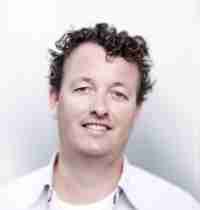The second half of the chessboard Already in 1965, Gordon Moore predicted in the Electronics Magazine that due to technological progress every two years the number of transistors on a chip will double. That prognosis is as yet released each year and is also known as Moore’s Law. The constant of two years is later revised downwards to 18 months. In the past thirty years, this exponential growth is not only observe in the power of processors, but also in memory, storage, bandwidth and the number of electronic sensors follow this line of explosive growth. Inventor and futurist Ray Kurzweil explains in his book “The Age of Spiritual Machines: When Computers Exceed Human Intelligence” how the inventor of chess shows his creation to the emperor of his country. The emperor was so delighted with the game, that he asks the inventor how he will be rewarded. The inventor tells the emperor that he wants to be paid in rice grains according to the number of squares on the game board. With each square, the rice should be doubled. So on the first square is one grain of rice, the subsequent surface has two grains and thus doubles the number itself with each new playing surface. “After thirty-two squares, the emperor had given the inventor about 4 billion grains of rice. That’s a reasonable quantity — about one large field’s worth — and the emperor did start to take notice. But the emperor could still remain an emperor. And the inventor could still retain his head. It was as they headed into the second half of the chessboard that at least one of them got into trouble.” The point that Kurzweil makes is that a constant doubling and other forms of exponential growth are misleading because they are not initially noticed. At first glance a standard linear increase appears, but after a while – when we reach the second half of the chessboard – exponential growth exceeds our expectations and intuition. The linear acceleration beyond what has appeared leaves piles of rice the size of Mount Everest assume. In the book “Race Against The Machine, How the Digital Revolution is Accelerating Innovation, Driving Productivity, and Irreversibly Transforming Employment and the Economy” the authors Erik Brynjolfsson and Andrew McAfee make the point that the amount of computers has reached the second half of the chessboard. To support this claim, they look at the time when the term “Information Technology” was first used. In 1958 The U.S. Bureau of Economic Analysis used the term “Information Technology” for the first time. That year, according to both authors was the benchmark to determine where on the chessboard, we now find ourselves. Assuming a constant doubling of eighteen months, they come to the conclusion – after thirty-two doubles – that the year 2006 is the turning point. In 2006 we have reached the second half of the chessboard. Measurement is the new knowledge Eric Schmidt, the former CEO of Google, draws a similar conclusion as Brynjolfsson and McAfee. On August 4, 2010, Schmidt participated in a panel discussion during the Technomy conference in Lake Tahoe. In his introduction he shared the following impressive figures with the audience: “There was five exabytes of information created between the dawn of civilization through 2003, but that much information is now created every two days, and the pace is increasing…People aren’t ready for the technology revolution that’s going to happen to them.” Now it takes two days to collect five exabytes of data. Within not too long, the same amount of data will be created in just five minutes. We are literally drowning in this tsunami of Big Data. For the article “The Age of Big Data” for The New York Times Erik Brynjolfsson was interviewed by journalist Steve Lohr. During the interview, Brynjolfsson said the following: “To grasp the impact of Big Data, look to the microscope, invented four centuries ago. It allowed people to see and measure things as never before. Data measurement is the modern equivalent of the microscope.” We are at the beginning of a new era, similar to the start of modern science. Finally we are using advanced hardware and software that is able to quickly zoom in and out, in order to discover new structures and new relationships for dramatically better insights, decisions and solutions. In the article “The Big Data Boom Is the Innovation Story of Our Time” in The Atlantic magazine Brynjolfsson and McAfee articulate as follows: “Breakthroughs in innovation often rely on breakthroughs in measurement.” IT does matter In 2004, Nicholas Carr wrote the book “Does IT Matter?”. A book that caused great commotion. In the book, Carr defends the thesis that IT is no longer distinctive. IT is like electricity and water turned into a utility function. According to Brynjolfsson, the assertion is untenable. The network, the underlying infrastructure is perhaps not crucial, but access to the information leads indeed to competitive advantage, “Applied information technology has become the primary tool with which leading companies in many industries have begun to separate themselves from competitors.” Companies that have a higher information metabolism have an ability to accelerate, because they are better and faster in analysing, interpreting, and based on this information, take action. Business models and the singularity The technologies now follow each other so quickly that the world has escalated. In the article “Business Models and Singularity” the author Greg Satell asks the question what the impact of these technological innovations is on the decision making processes of companies. Can companies still afford to not adapt to their rapidly changing environment? Do companies have to oppose against all these new technologies or should they embrace them? At the end of his article Satell makes the following observation that “business models can no longer be treated as stone tablets divined by wise men on mountains to last for eternity”. It is also reminiscent of the principle of Clay Shirky: “Institutions will try to preserve the problem to which they are the solution.” Accelerated change is the only constant “Panta Rhei” is a famous saying of the Greek philosopher Plato. The expression refers to a world that is constantly in motion. Everything changes, nothing stays the same. “One can not step twice into the same river, for it is always fresh water that flows to meet you.” The real-time information that companies are facing is getting bigger and bigger and flows faster and faster. The world around us is changing with accelerated speed. Companies must learn to deal with this. Or as Charles Darwin once said so beautifully: “It is not the strongest of the species that survives, nor the most intelligent that survives. It is the one that is most adaptable to change”.
Select your location
 English | EN
English | EN


